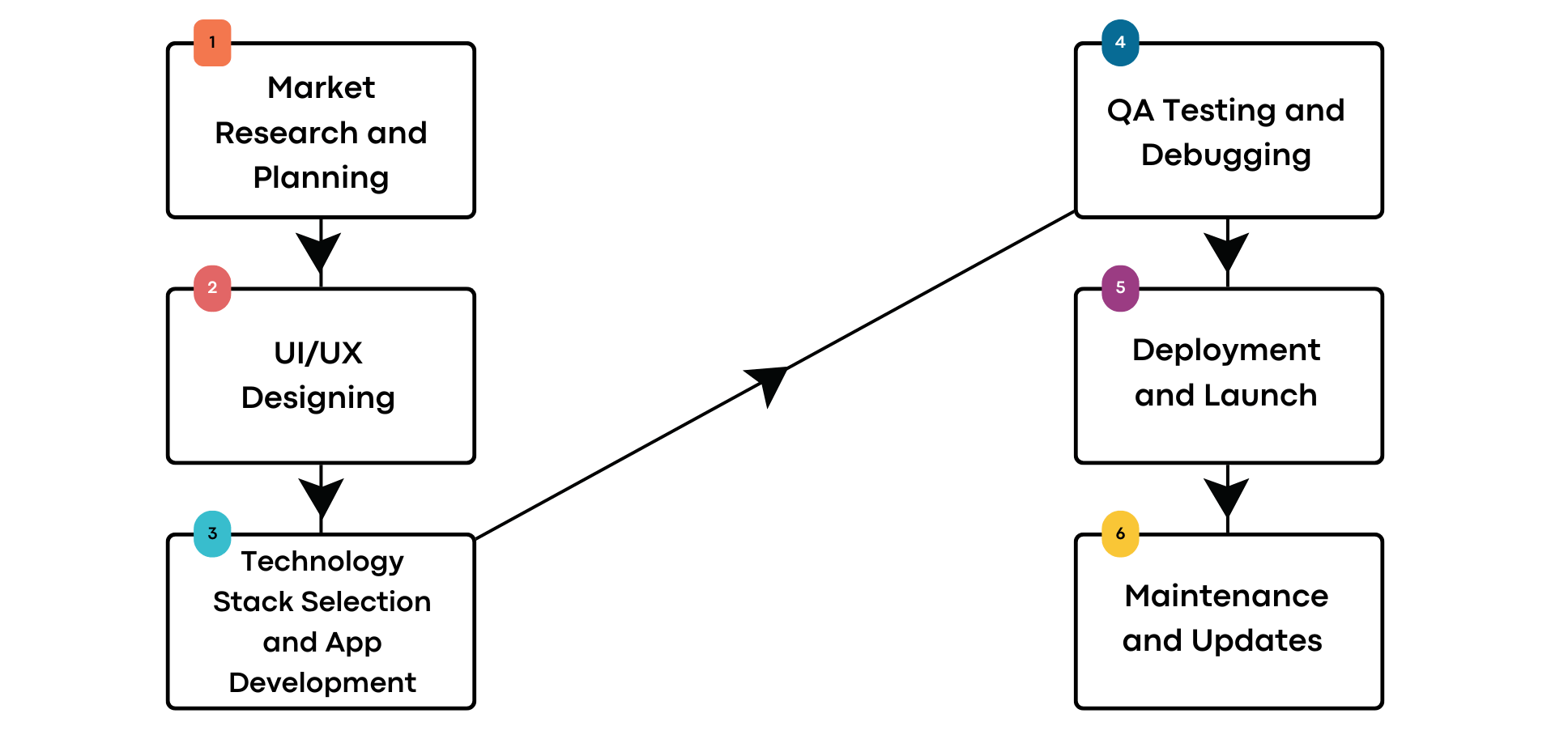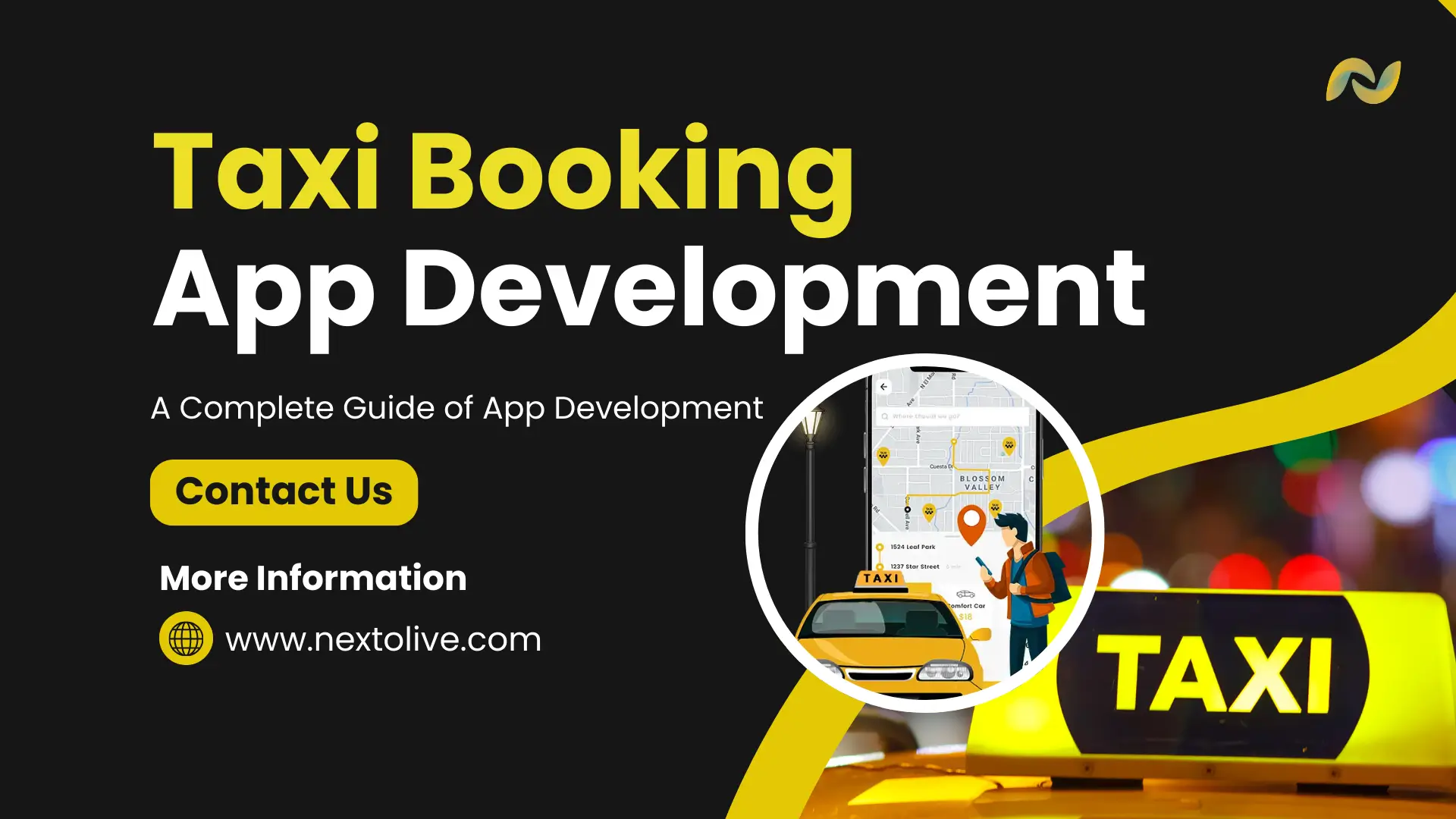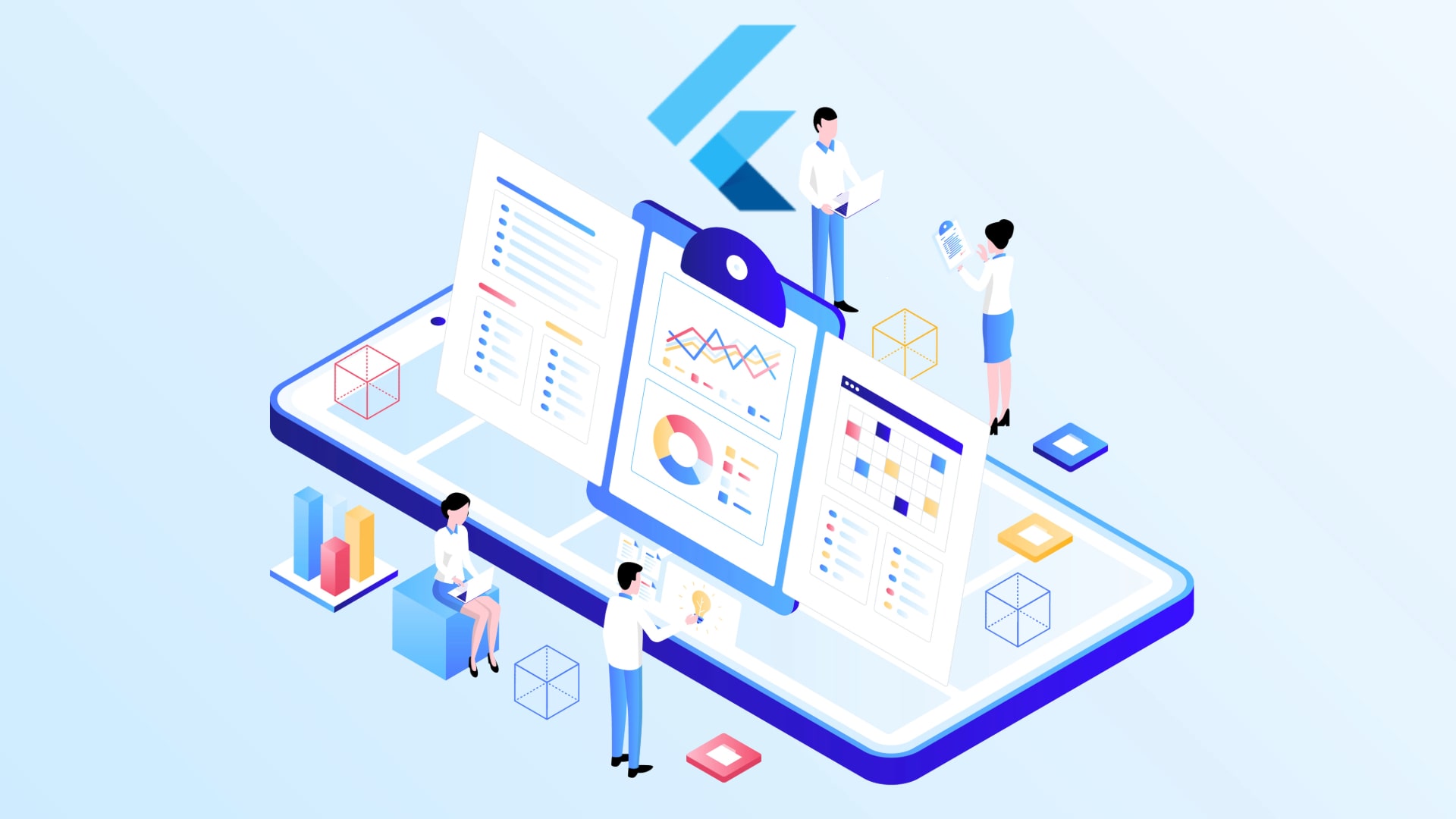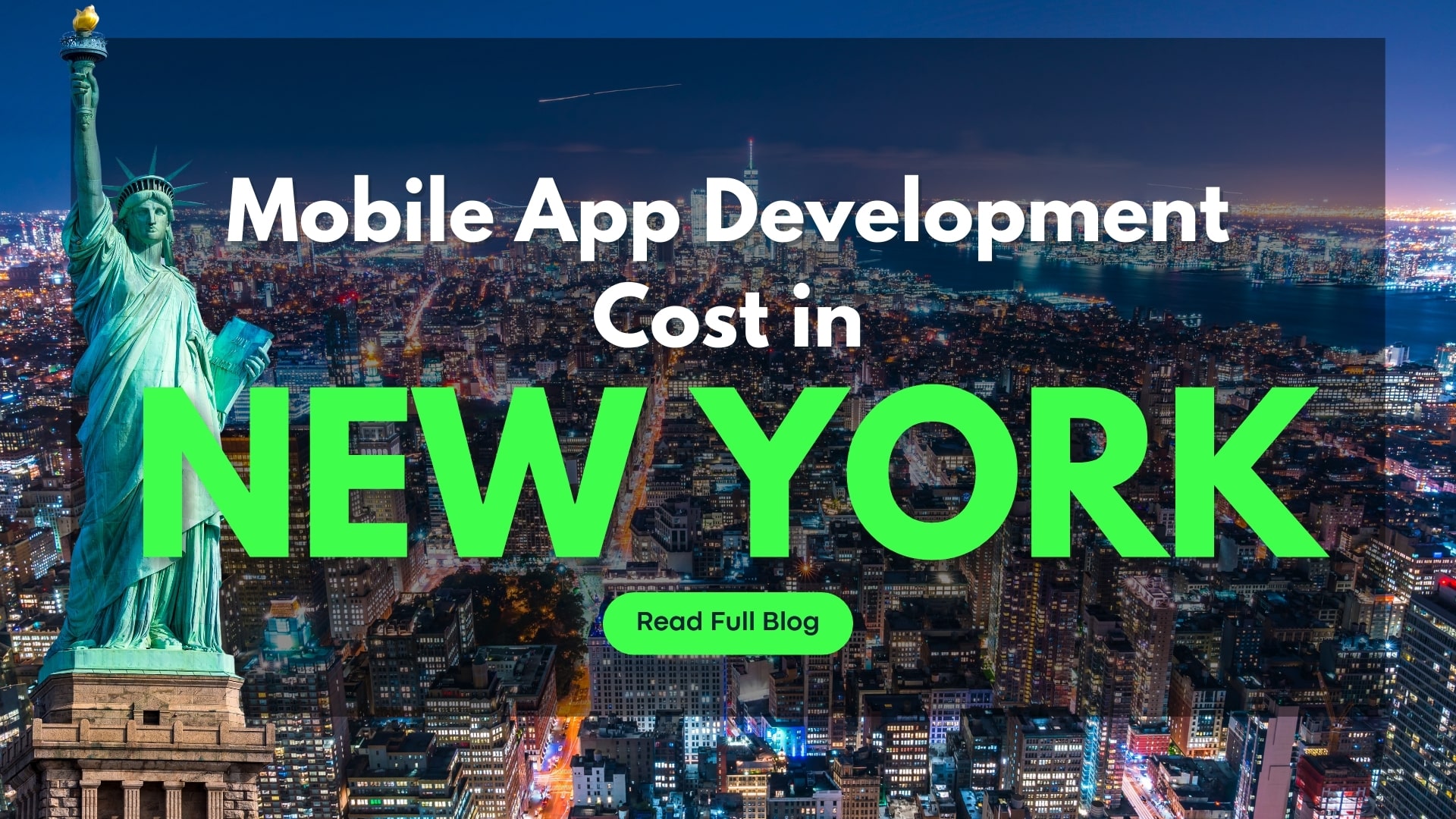Taxi Booking App Development: Features, Cost, and Technologies
In the modern era, booking a taxi has become an easy task. Taxi booking applications have changed the way people travel. People of different ages can quickly book a taxi to their destination in no time. This guide aims to help developers and entrepreneurs develop their taxi app with a user-friendly and engaging interface. This guide walks you through the details of taxi booking app development and the key factors that influence the success of the application. Let’s dive in!
Table of Contents
ToggleWhat is a Taxi Booking App and Its Development?
As the name suggests, a taxi booking app is a digital platform through which users can connect with taxi drivers, making the transport more efficient and accessible. Using this app, passengers would not have to wait on the roadside, waiting for a taxi. Instead, they can simply tap a few times, and their ride will come to their location. On the other hand, taxi booking app development is the process of creating a taxi app from scratch using the latest technologies, programming languages, and development frameworks. The process involves creating a user-friendly interface and a robust backend with navigation, security, pricing calculation, payment gateway, etc. Taxi app development is a lengthy process and involves several important stages.
How Does a Taxi Booking App Work?
The working of a taxi booking mobile app is pretty straight forward. First, the passenger opens the app and selects the pickup location and desired destination. The application then calculates the fare, and a list of available nearby cabs and their estimated time to reach appears. The user can select the driver and an app will send a notification to the driver’s panel of the pickup and drop location. Once the booking is confirmed, the user can easily track their ride using real-time GPS navigation and receive regular updates. Once the user reaches their destination, they can pay the driver using in-built payment options such as cash, cards, or digital wallets.
Benefits of Taxi Booking Mobile App Development for Your Business
[1] Enhanced Customer Service
The customer is the king of every business. A taxi booking app provides convenience to the customers by offering them instant ride booking services without spending much time as compared to the traditional ride booking method. Users can easily book a ride in one tap and can also track their location in real-time using a GPS navigation system. The app also has multiple payment options and 24/7 availability to make the experience of the application smoother and seamless.
[2] Automation and Efficiency
Automation of services and operations eliminates manual tasks and saves a lot of time and resources for the business. Using AI and ML algorithms, taxi booking apps can match passengers with the nearest available drivers, which helps to reduce the waiting time and maximize fleet utilization. With turn-by-turn navigation, drivers can minimize travel delays and save fuel. Also, AI-powered customer support enables faster and efficient query responses for the customers.
[3] Increased Brand Visibility
Since a taxi booking app is a digital platform, it is available to a wider range of users. Hence, it can be easily downloaded by users anywhere and anytime. Integrating social media and referral programs can boost your organic traffic. Personalized push notifications can alert users about new discounts, offers, and services of your application. These things help to build a powerful brand identity along with trust and loyalty among customers and help your app to stand out in the market.
[4] Data-Driven Insights
Data is everywhere, and companies are using this data to make smart and data-driven decisions. A taxi booking application can help businesses make informed decisions. AI-powered data analytics enables businesses to identify patterns and trends and generate detailed reports on user activity, peak booking times, and preferred routes, helping make strategic decisions.
[5] Improved Safety
Safety is the utmost priority of users and the app itself. Taxi apps have some serious security features for the safety of the passengers. Passengers can share their ride details and live location with their friends and family members. Emergency SOS buttons can help passengers in unforeseen circumstances. Identification and verification of drivers and the vehicle to ensure a safe, reliable, and trustworthy riding experience.
Global Market Statistics of Taxi Booking App in 2025

As per the report by Business of Apps, the global market cap of taxi application development in 2023 was $220 billion and grew to $239 billion in 2025. With a CAGR of 4.2%, the market size is expected to grow to $283 billion by 2028.
Types of Taxi Booking Apps
[1] On-Demand Taxi Booking Apps
These kinds of applications allow users to book a taxi whenever and wherever they want to. These apps offer real-time location tracking, updates, and accurate fare estimation. On-demand taxi apps have multiple payment options such as cash, card, digital wallet, or UPI. Passengers can give reviews and ratings for the ride and service.
[2] Corporate Taxi Booking Applications
Corporate taxi applications provide reliable and convenient ride services to employees and executives. These apps feature centralized billing, ride tracking, and automated expense management. Businesses can easily schedule rides in advance for daily commutes, airport transfers, and meetings while ensuring timely pickup and drop-off.
[3] Ride Sharing Apps
Ride-sharing applications help to connect passengers who are travelling in the same direction or to the same destination, reducing costs, traffic congestion, carbon emissions, and environmental impact. These applications match the rider’s routes and preferences to ensure efficient commuting.
[4] Luxury and Limousine Booking Apps
These apps offer high-end and premium transportation services to users on special occasions and business travel. These apps have features such as real-time ride booking, route optimization, and personalized ride preferences. Customers have the freedom to select the type of vehicle, such as sedan, SUV, Limo, etc, for a comfortable experience.
[5] Cab Booking Apps
Cab booking apps offer convenient riding services for daily commutes and intercity travel. These applications offer various riding options, such as SUVs and hatchbacks, etc with features such as transparent pricing, estimated fares, payment options, etc. These apps also have driver and vehicle verifications to ensure the safety of the passengers.
[6] Bike Taxi Apps
Bike taxi apps are one of the most popular types of taxi service apps. These apps enable customers to book a bike taxi for solo travel. These apps are best for towns and cities with narrow lanes and roads with heavy traffic, as bikes can easily commute through these routes effectively and quickly. Riders receive a helmet, and there are multiple payment options for the bike taxi service as well.
[7] Airport Taxi Booking Apps
As the name suggests, airport taxi applications specialize in airport transfers and ensure timely pickups and drop-offs of passengers. These apps also offer real-time flight tracking to easily adjust the pickup time in advance. The service is available 24/,7 and the rider has various options of vehicles such as luxury cars, SUVs, or a simple hatchback.
Essential Features of Every Taxi Booking App
[1] User Registration and Login
Users can create their account with details such as name, contact number, profile photo, etc. Easily log in and log out of the app with one click.
[2] Real-Time Location Tracking
Passengers can track the real-time location of their ride with the estimated time to arrive at the pickup point.
[3] Multiple Payment Options
Multiple payment options such as cash, card, digital wallet, etc, so that if one is unavailable, the user can opt for the other to pay for the ride.
[4] Ride Scheduling
Users can plan and schedule their ride in advance, as per their date and time, to ensure convenience for scheduled routes.
[5] Fare Estimation
Provides the customer with an estimate of the total fare in advance to avoid confusion later during final payment.
[6] Driver and Vehicle Details
Customers can get the details of the driver and the vehicle. This ensures that only verified drivers and vehicles are added to the fleet and builds trust among customers.
[7] In-App Call and Messaging
In-app call and messaging enable the driver and the customer to contact each other when necessary.
[8] Emergency SOS Button
This feature helps the customer to contact emergency services and trusted people in case of an emergency.
[9] Reviews and Ratings
Customers can read and give reviews of the taxi service, including the reviews of the driver and the ride.
[10] Ride History and Invoice Generation
Customers can see their ride history, view and generate invoices, and track their expenses.
[11] Promo Codes and Discounts
Offer promo codes, rewards, and discount coupons to boost customer engagement and increase the retention rate.
[12] Admin Panel
Admin panel enables full control of the app by the owner and provides analytics related to performance, payment, and driver, etc.
Various Panels of Taxi Booking Applications
[1] Admin Panel
- {1} Dashboard and Analytics: This feature enables the admin of the whole app oversee the metrics related to performance, driver, revenue, etc and also displays real-time statistics of the fleet.
- {2} Driver Management: Add, remove, or edit drivers. Approve or reject the driver application based on documents or background verification. Monitor the driver ratings and feedback.
- {3} Passenger Management: View and manage the user profiles. Track and manage ride complaints and history. Manage fare disputes and refunds of the passengers.
- {4} Payment and Fare Management: Easily configure surge pricing, fare calculations, and discounts. Track the driver earnings, commission, and payments.
- {5} Location Management: Define the restricted areas and service zones. Set fare rates based on city and region. Manage airport and railway station pickup zones.
- {6} Ride and Booking Management: Display the ongoing, completed, and scheduled rides. Assign the ride manually in case of system failure. Manage ride reassignments and cancellations.
- {7} Dispatcher Dashboard: Manually dispatch rides for corporates and emergency bookings. Monitor the availability of drivers and assign accordingly.
- {8} Ratings and Reviews Management: Track and manage user feedback and driver ratings. Take strict action against fraudulent activities and low-rated drivers.
- {9} Discounts and Promo Codes Management: Create and manage promotional offers for users. Track the effectiveness and usage of discounts and offers.
- {10} Security Settings: Monitor suspicious transactions and fraudulent activities. Ensure end-to-end data encryption and data login access.
[2] Driver Panel
- {1} Driver Registration and Profile Management: Create a user profile, upload documents, and get verified. Update profile, such as vehicle details and availability status.
- {2} Ride Acceptance and Request: Displays the incoming ride requests with pick-up and drop-off locations. Accept or decline the requests based on their availability.
- {3} Navigation and Route Optimization: GPS-based navigation for efficient route planning. Suggest the best route to minimize travel time.
- {4} Earnings and Payment Tracking: Displays the daily, weekly, and monthly earnings with detailed breakdowns. Multiple payment methods such as cash, card, or digital wallet.
- {5} Ride History and Reports: A detailed record of completed rides for reference and dispute resolution.
- {6} In-App Chat and Calls: Connect with the customers for effective communication and coordination. Ensures privacy by hiding phone numbers.
- {7} Reviews and Ratings: Displays the ratings and reviews given by the passengers to help the driver improve their service quality. Drivers can also give ratings to the passengers for better ride experiences.
- {8} Emergency SOS Button: The SOS button enables a quick emergency alert for safety concerns. Connects the driver with support teams and local authorities.
- {9} Demand Insights and Surge Pricing: Provides notification to the drivers of areas with high demand. Displays the surge pricing details for maximizing income during peak hours.
- {10} Vehicle Maintenance and Inspection Alerts: Notifies the driver for timely vehicle maintenance and document renewals. Ensures compliance with regulatory and safety standards.
[3] Passenger Panel
- {1} User Registrations and Profile Management: Create the user profile with details such as name, phone number, email, payment methods, profile picture, etc.
- {2} Ride Booking and Scheduling: Users can easily book rides or schedule them for later. There are options such as vehicle type, estimated fare, and ride preferences.
- {3} Real-Time GPS Tracking: Users can track their ride in real-time using in-built GPS navigation features.
- {4} Fare Estimation and Payment Options: This feature shows the upfront pricing of the ride based on demand, location, and distance. Users can select one of the many payment options available, such as cash or card etc.
- {5} Driver and Vehicle Details: Users can get the details of the driver and the vehicle during ride booking. This ensures transparency and security for the passengers.
- {6} In-App Call and Chat: Communicate with the driver in real-time for coordination.
- {7} Emergency SOS Button: This feature is used to alert the authorities and close contacts in case of emergencies.
- {8} Ratings and Reviews: Users can give ratings and write reviews for the ride experience and the driver.
- {9} Ride History and Invoice Generation: Users can see their ride history, track expenses, and view receipts.
- {10} Promotional Codes and Discounts: Apply promo codes and discounts on rides to save expenses.
Taxi Booking Application Development Process

[1] Market Research and Planning
Every successful application development begins with proper market research. Perform extensive market research and analyze your competitors to see the pros and cons of their services, along with gaps and potential opportunities. Before you create a taxi app, it is essential to develop a detailed project plan that includes pricing strategies, business models, tech stack selection, development methodology, etc.
[2] UI/UX Designing
Now that the plan is created, it is time to start designing the prototype of the app. Start by developing an MVP app with core features and functionalities. Ride-hailing app development requires creative thinking, and it is crucial to develop the user interface and user experience of the app. Once the MVP is developed, get it approved by the client and refine it for more improvements.
[3] Technology Stack Selection and App Development
Select the appropriate technology stack and development frameworks for the app project. In taxi mobile app development, you can use popular tech stacks such as MERN, LAMP, MEAN, etc. After that, start developing the frontend and backend of the app. The frontend should have a responsive, fast, and sleek UI/UX design, and the backend should have proper security measures, data storage and transfers, payment gateway integration, etc.
[4] QA Testing and Debugging
After the app is fully developed, it is time to conduct proper testing of each aspect of the app. Test cases are prepared to test a certain aspect of the app. Various types of tests are conducted on the app, such as unit, functional, integration, non-functional, security, user acceptance, etc. Testing ensures the app is of the highest quality and meets the client’s expectations.
[5] Deployment and Launch
Deploy the app on the respective platforms, such as Android and iOS. Submit the app on the Play Store and App Store along with the fees. Then, wait for the approval. The approval takes from several hours to weeks. Once approved, the app is launched for public use. Extensive marketing and promotional campaigns are launched to market the app over a wider audience.
[6] Maintenance and Updates
Every application after the launch requires regular monitoring to look for potential issues during runtime. Maintenance and regular updates ensure the app remains error and bug free along with new features and functionalities to keep the app relevant and competitive in the market for a long time.
Select Among the Popular Business Models
[1] Commission-Based Model
This is one of the most widely used models. In this model, taxi booking applications charge a percentage of the earnings from the drivers on every ride booked through the platform. The commission rate depends upon several factors such as location, demand, and driver performance, etc. This model works best when the number of app users increases.
[2] Subscription-Based Model
In this model, the drivers or passengers can pay a periodic fee on a monthly or yearly basis to unlock premium features and functionalities such as advanced bookings, lower service charges, priority rides, etc. Users who subscribe can get exclusive discounts on fares. It is best for frequent passengers who rely on taxi services for their daily commute.
[3] Surge Pricing
Surge pricing model works best when there is a high demand for taxi services in a given period of time. Factors such as bad weather, peak hours, or special events, etc, lead to an increase in price and encourage more drivers to work. Customers with urgent needs would pay an extra amount. The surge pricing is calculated based on real-time traffic and booking patterns.
[4] Advertisement Model
The taxi app can offer ad slots to various companies and bands to advertise their products and services on the app. Advertisers target users based on factors such as location, preferences, and travel behavior etc. This model works best for applications with a large user base, which ensures high visibility for advertisers.
[5] Corporate Ride Solutions
In this model, companies can partner with taxi booking apps to provide their employees with rides for work-related travel, while paying the app on a monthly or per ride basis. This ensures confirmed bookings for the app and convenience for the corporate employees. Taxi apps can offer expense tracking tools and priority support to companies using their services.
[6] Car Rental Model
Taxi applications can offer car rental services for a few days or a few hours. Customers can easily book the car for personal trips or business trips without a full-time driver. The price of the rent depends on the vehicle type, duration, location, distance travelled, etc.
Leverage the latest Technology Stack for Taxi App Development
[1] Frontend Development
- Mobile Development: Kotlin, Swift, React Native.
- Web Development: React.js, Angular.js, Vue.js.
- UI/UX Designing: Adobe XD, Figma, Sketch.
[2] Backend Development
- Languages: Python, Java, Ruby on Rails, Node.js.
- Development Frameworks: Spring Boot, Express.js, Django.
- DBMS: MySQL, PostgreSQL, MongoDB.
[3] Hosting and Cloud
- Services: AWS, Azure, GCP.
- Hosting: Firebase, DigitalOcean, Heroku.
[4] Third-Party Integrations
- Stripe, PayPal, Razorpay, Google Maps API, Mapbox, OneSignal, Firebase Cloud Messaging, OAuth, Firebase Authentication.
[5] Analytics
- Mixpanel, Google Analytics, Tableau
[6] Security and Compliance
- SSL/TLS, AES Encryption, GDPR, PCI-DSS
Integration of Emerging Technologies in Taxi Booking Mobile Application Development
[1] Artificial Intelligence and Machine Learning
AI and ML are game-changing technologies that are extensively used in taxi booking applications. AI/ML is used in taxi apps to predict demand, analyze user behavior, and optimize routes. It also helps to reduce waiting time, improve fare estimation, and enhance customer support using AI-powered chatbots.
[2] Internet of Things
IoT is used in taxi applications in many ways. IoT-enabled sensors installed in the vehicle help to monitor driver behaviour, track in real-time, and ensure the overall vehicle health.
[3] Blockchain Technology
Blockchain is used to ensure secure payments and prevent any fraud while offering transparency in each transaction. It also removes dependencies on third-party services for payment processing while offering a decentralized system.
[4] Big Data and Predictive Analytics
Data is generated by the app every day, and businesses can utilize this data to make data-driven and informed decisions by analyzing traffic patterns, user behavior, peak hours, and optimizing driver allocation.
Cost of Taxi Booking App Development in 2025
The taxi booking app development cost in 2025 depends upon several important factors such as:
[1] Size and Complexity
When it comes to determining the cost of a taxi app, the size and complexity play an important role. If the app is small in size, its complexity will be less, and it will require less time and resources to develop. Hence, the cost will be less. On the other hand, if the app has advanced features and integrations such as AI/ML, it will consume more time and resources and will cost more to develop.
[2] Platform
If the app is developed for a single platform, such as Android or iOS, it will cost more to develop due to the time and resources needed for developing individual platforms. Meanwhile, if you opt for cross-platform development, the cost of developing the app would be reduced since a single codebase will be used to develop the app for multiple platforms.
[3] Development Team
The development team also plays a crucial role in determining the app development cost. A small team would be best suited for small and medium-sized projects, as it will charge less. If the app is larger and requires complex integrations, the team size would be much larger as it will consist of developers, testers, project managers, designers, etc, and would charge more, leading to higher development costs.
- Basic Application: $5,000 to $35,000.
- Medium Complexity App: $35,000 to $80,000.
- High-Complexity App: $80,000 to over $150,000.
How to Select a Reliable Taxi Booking App Development Company
Selecting a reliable taxi app development company is not a simple task and requires a lot of research and careful consideration. Begin the research by looking into the portfolios of selected companies that provide taxi app development services. Check their success rate, client reviews, case studies, etc, and whether they incorporate open and transparent communication with the clients. Also, ensure they deliver the app on time and collaborate with the client in every step of the development process. Next Olive is one such company that has been offering all these facilities to clients for over 13 years. The company has a team of over 100 taxi app developers and offers its services in over 20 different countries, such as the USA, UK, Australia, Saudi Arabia, etc.
Conclusion
In this comprehensive guide, we explored the various types of taxi booking apps available and the various factors that influence their development. We also discovered the essential features of the application, the panels that make up the user interface of the app. The cost of developing a taxi app depends upon various factors such as size and platform the various technologies that enhance the taxi booking application.
Frequently asked questions (FAQs)
The time required to develop an app like Ola depends upon several key factors such as type, size, a complexity of the project. Generally, it takes about 2 to 3 months for a basic app, 3 to 6 months for a medium-sized app, and 6 to more than 10 months for a highly complex app.
The cost of creating a clone of Uber depends on the complexity and features of the app.
- Basic App: $5,000 to $30,000.
- Medium-Sized App: $30,000 to $70,000.
- Large-Sized App: $70,000 to over $160,000.
Next Olive has a team of over 100 taxi booking application developers. The firm also provides freelance developers for hire.
It is a pre-built application that can be used by taxi services providing companies to customize it and rebrand it as their own.








